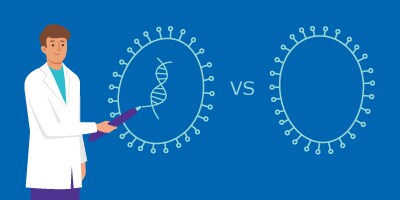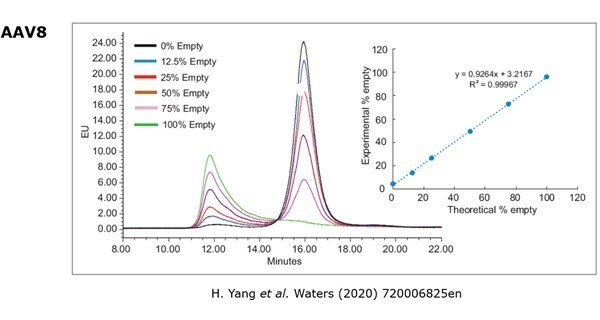Strategies for the Separation and Analysis of Empty and Filled Capsids During Viral Vector Production

Empty capsids are viral capsids that do not contain vector genome, formed when adeno-associated viruses (AAV) are packaged for use as viral vectors in gene therapy. The therapeutic role of empty or partially filled capsids is not fully understood. It is believed that empty capsids provide no therapeutic benefit and may actually increase the innate or adaptive immune response in patients receiving gene therapy.1 They are considered product-related impurities that, according to US Food and Drug Administration (FDA) guidance,1 should be characterized and monitored as they may impact product safety and efficacy.
While some manufacturers aim to achieve 100% full capsids from their process, others are comfortable accepting lower percentages. The push for a higher percentage reflects the safety concerns of high doses of AAV vectors, including possible liver dysfunction.2 The FDA has not yet set a threshold value for the appropriate percentage of full capsids as the clinical impact of empty or partially filled capsids is not sufficiently defined. The acceptable level of full capsids is based on clinical experience. As such, the goal for manufacturers should be to maintain a consistent percentage of full capsids across clinical phases, with an emphasis on robust preclinical and clinical trial designs to understand the tolerability of varying levels of purity on patients.
Visit our downstream application page here to learn more or watch our on-demand webinar on chromatography by clicking here.
Separation of AAV Full Capsids from Empty and Partially Filled
Cesium chloride and iodixanol-based ultracentrifugation are commonly used for small-scale preps and first-generation processes in the academic setting. In larger-scale manufacturing, however, a chromatography-based approach using anion exchange is more desirable due to its scalability.
Anion exchange chromatography has been widely explored for the separation of full from empty or partially filled capsids, due to its scalability, high throughput, and reduced sample preparation. With current methods, a good separation efficiency between full and empty capsids at low process yields can be achieved, or a higher overall process yield can be achieved with low separation efficiency. Even with preexisting process knowledge, time-consuming process development work is needed to optimize parameters such as salts and process additives. A further complication is that AAV can show aggregation under certain process conditions.
Development of a Manufacturing Template for Capture and Separation of Capsids
While current approaches for single serotype affinity purification tend to enable better process economics, higher yield, and higher impurity reduction, they are only applicable for one specific serotype. Development of different affinity solutions will provide more options for separation. A universal approach for separation of full from empty or partially full capsids without the use of affinity would also offer greater process flexibility. In this scenario, only one approach would need to be validated which can then address multiple serotypes.
We are currently developing novel membrane absorbers in collaboration with leading academic institutions in the field. This single-use, plug-and-play, serotype independent process is especially suited for custom made serotypes in discovery or pre-clinical for candidate selection. Chromatography membranes have high volumetric throughput due to pore sizes in the 0.5–5 µm range and low bed heights attained with stacks of 3–16 membrane layers.3 Gel-layer structures are surface coatings that help to boost capacity. Coatings are very thin to decrease diffusion distances and preserve mostly convective mass movement. As such, this technique is not limited by diffusion and binding capacities are not affected by flow rate.
Changing the stationary phase in this manner offers many benefits including higher flow rates of up to 10 mL/min.4 This enables processing over larger sample volumes, while reducing buffer consumption. Because convective flow behavior is feasible with larger pore diameters, mass transfer constraints are reduced. Excellent binding efficacy is enabled by direct access to functional groups and high flow rates.
A universal manufacturing template for AAV not only includes a universal capture step, it also requires a universal approach to separate full from empty capsids. Both resins and membrane absorbers offer potential for empty-full separation. Small resin particles based on anion exchange chemistry, such as Fractogel® resins, hold promise when applied to a hybrid gradient in finding the balance between process yield and separation efficiency for full and empty capsids. These resins can potentially be used in a multi-column approach to further improve efficiency and productivity.
The use of membranes, however, offers much greater flexibility and potentially greater productivity when compared to chromatography resins. Natrix® CH membranes, with a unique multi-modal chemistry that includes sulfonic acid and butyl groups, can be used for capture of AAV capsids. With further optimization, it may be possible to separate empty from full capsids in a single step. This project is also part of the collaboration with academia noted above.
Analytical Characterization of the AAV Empty/Full Capsid Ratio
There are several possible analytical approaches to measure the empty/full capsid ratio including UV spectroscopy which uses an A260 to A280 ratio to determine empty/full capsid ratio. This method is simple, but it is very sensitive to the presence of any simple components that absorb light at either 260 or 280 nm. A combination of orthogonal approaches such as quantitative PCR (qPCR) and ELISA is preferable; qPCR is used to quantify the viral genome and ELISA is used to quantify the viral particles. The empty/full capsid ratio is the determined based on comparison of results. Another method is transmission electron microscopy which provides quality data but requires specialized equipment and time-consuming data analysis.
Anion exchange chromatography is one of the most commonly used methods for determination of the empty/full capsid ratio; it relies on differences in surface charge to distinguish between the two.5 Figure 1 shows a separation of empty and full AAV8 capsids. To obtain the empty/full ratio, peaks representing empty and full capsid are integrated and their peak areas compared. Anion exchange is a high throughput method that is easy to execute, generates data that is easy to analyze and only requires a small sample volume. It is important to note that the method is serotype dependent, which means that a serotype specific method must be developed for each serotype.

Figure 1.Empty/full capsid analysis by anion exchange chromatography.
Analytical ultracentrifugation is widely recognized as a gold standard method for determining the empty/full AAV capsid ratio. This method offers high resolution separation, allowing for quantitation of empty partial and full capsids where partial capsids contain partial or truncated fragments of the gene or capsid with contaminant from the host cell. While this method is stereotype independent, it is more complex to execute and requires higher sample volume than the anion exchange chromatography method.
Novel methods that hold promise for empty/full capsid analysis include size exclusion chromatography and anion exchange chromatography with multi-angle light scattering. These methods offer the potential to be a single approach for all applications, providing information on the full/empty ratio, capsid titer, and level of at-line aggregation.
This initiative is related to our program with the National Institute for Innovation in Manufacturing Biopharmaceuticals (NIIMBL) focused on developing a microfluidic detection device in a single, portable device format. Another innovative concept in development with NIIMBL is a microfluidic detection device in a single, portable device format. This would enable the determination of full–empty capsids on a single, portable device in a simple format.
Upstream Strategies for Reducing the Level of Empty and Partially Filled Capsids
Novel upstream approaches may help reduce the percentage of empty and partially filled capsids including improvements in HEK-based production systems and use of baculovirus expression systems where the percentage of full capsids are generally higher at the end of harvest. While the use of insect cells may lead to more full capsids, there will also be higher levels of feed impurities that then put pressure on downstream purification steps.
Trends in AAV Capsid Design Impact Purification
Historically, AAV serotypes 1 through 10 have been used as viral vectors. Hybrid serotypes are now emerging through novel capsid design, artificial intelligence, and machine learning, and offer higher transduction efficiencies than currently available serotypes and enable new targeting strategies. For example, novel serotypes such as AAV-DJ, AAV-DJ/8, rh10, and AAV-PHP, can target the central nervous system.
The need to separate empty/partial capsids will remain, ensuring that release criteria guiding patient safety can be achieved. Moving to templated chromatography processes is desirable, although this will likely be via a case-by-case approach depending on the complexity of separation required for these new serotypes.
For more information, please watch our on-demand webinar on chromatography techniques for downstream purification here.
If you are looking for more information on all our downstream offerings, please visit our downstream application page here.
References
Disclaimer
Fractogel® resin may not be used in commercial manufacturing processes for the separation of empty and full AAV capsids, such AAV capsids are intended for human therapeutic use and which use has received regulatory authority approval for commercial sale, without prior consent by the owner of EP 2 277 996 (Genzyme Corporation, Cambridge, MA) and/or US 8,137,948 (Genzyme Corporation, Framingham, MA) and/or US 9,528,126 (Genzyme Corporation, Cambridge, MA). Purchase constitutes an agreement by the purchaser that the product may not be used in commercial manufacturing processes for the separation of empty and full AAV capsids, such AAV capsids are intended for human therapeutic use and which use has received regulatory authority approval for commercial sale.
To continue reading please sign in or create an account.
Don't Have An Account?